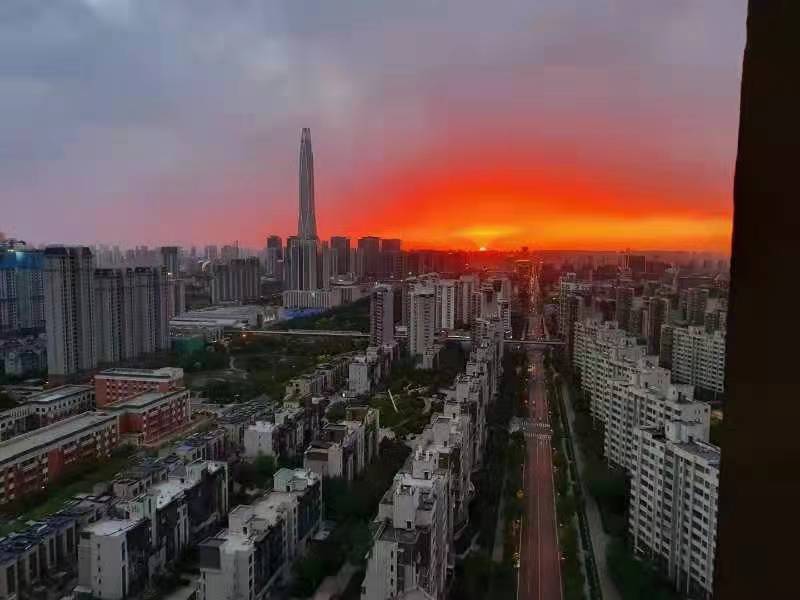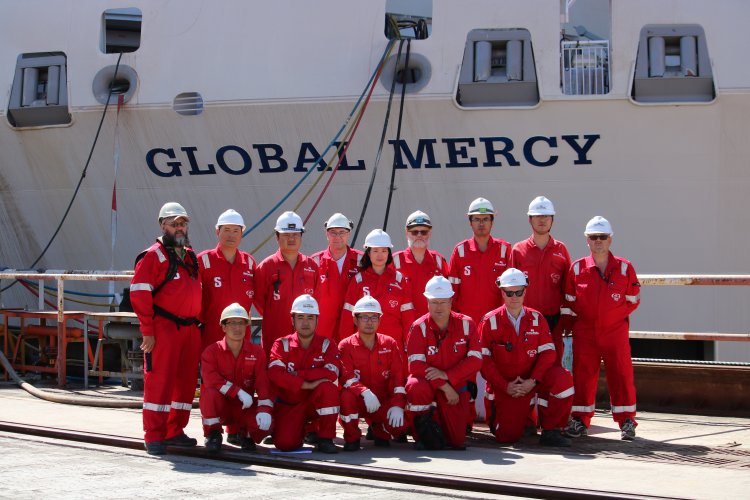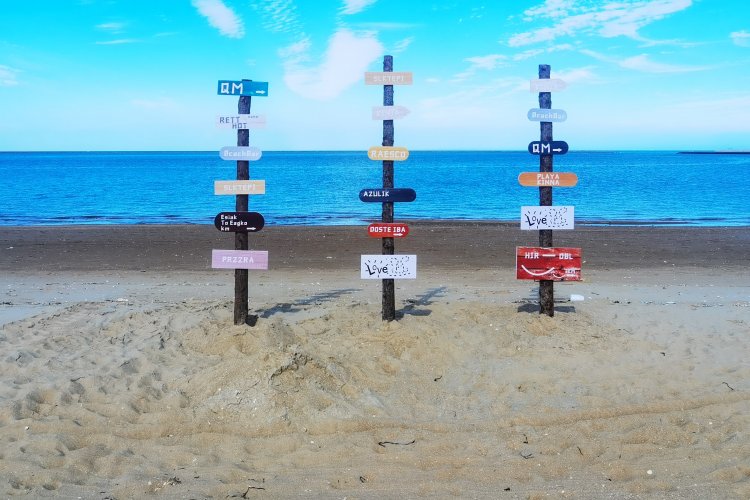Last of the Tall Towers: The Tianjin CTF Finance Centre
Recently, I had the privilege of visiting and touring a rather special tower in Tianjin, and one that may quite possibly end up being the last of a dying breed of a certain type of building.

Art, Innovation, and Beyond!
I first knew the building as “K11,” but the name of the building itself is the Tianjin Chow Tai Fook Finance Centre. K11, on the other hand, is an art-commercial fusion concept brand that was founded in 2008 by Hong Kong businessman Adrian Cheng. It has projects in several cities across China, including Shanghai, Hong Kong, Guangzhou, Wuhan, Shenyang, and now here in Tianjin, which is about an hour by train away from the heart of Beijing. In my opinion, K11 is much more than just a brand. It is a lifestyle, it is a landmark, and it is a beacon to all around the world seeking something new, interesting, diverse, contemporary, and artistic. The company describes itself as an “Art Playground—where culture, entertainment, shopping and living revolve around art” and “where ideas, trends and lifestyles collide to form new ideas and new inspirations.” Within the Tianjin CTF Finance Center, K11 has two development projects: K11 Select, an “Art Mall” and the first exploration of K11’s “museum-retail” concept in Tianjin, and K11 Atelier, which encompasses the office space development in the building.

On my first day visiting the Tianjin CTF Finance Centre, I spent the entire day there but there was still more left to see and do. Once finished and fully occupied, the building will be an intricate and artistic vertical city, and I imagine that you will be able to spend days in this tower and never run out of things to do. The first stop of my visit was the Starbucks Select Reserve, where I got coffee and did some work while waiting for my friend to show me her company’s office on the 23rd floor. If you prefer to try another coffee shop you can check out Chembox Coffee on the fifth floor, which will soon roast their own beans, and which also has a little outdoor rooftop garden area in which to sit and sip. My friend Dora Li gave me a tour of her company, the Tianjin Run Sen Culture Company, and I got a chance to see their presentation about what they do. It was really inspiring to learn more about their partnership with the British Museum and other famous museums around the world. After the meeting, I walked around in the five-story mall, known as K11 Select, that is located at the base of the tower. K11 Select was ridiculously cool, and I was consistently impressed with the building, brand, and overall atmosphere. The company says: “At K11 we believe in Art, and we believe in the forces that bring it to life. In addition to our permanent collection of local and international artists’ work, we also allow the public to appreciate art during their shopping and leisure time by providing various multi-dimensional spaces.” This philosophy was evident as I kept running into cool art around the mall. I had the feeling of being in an upscale mall, and yet just a few steps later of being in an exclusive contemporary museum. The entire Finance Centre building, including both the K11 Atelier office space and the K11 Select Mall, is full of art, imagination, and creativity, and truly surpassed my expectations of what a commercial can and could be.

I had brought my gym bag with me, and after checking out each floor of the mall area, I decided to try out the gym on the fourth floor. After my workout and shower, I had lunch at Nana and Her Friends, a fusion restaurant with a fantastic view. Next was my meeting and tour with David Sun, who is on the Brand Curation Team at K11 Atelier, and who was able to take me up a little higher, to the 43rd floor. This floor is the top of the office portion of the building, but it is not even the halfway point of this colossal building. The K11 Atelier office space goes from the ground floor of the Centre to the 43rd floor, and is made up of the lobby, meeting rooms, offices, and other business spaces. Of course, with such a modern and marvelous building, the offices come with some amenities that you probably won’t get in most other places, including two VIP bathrooms per floor, which include a shower and other VIP conveniences for all the hard-working execs. The other sections in the tower, which are still under construction, will include serviced apartments on floors 49-70, a hotel, club, executive lounge, presidential suite, and restaurant on floors 73-93, and of course the crown on the very top of the building. The crown is an aesthetic and artistic addition that is the cherry on top. It gives the building a bit of flair, as well as the coveted additional feet that these tall towers are all about.

In addition to the retail spaces, restaurants, salons, the gym, etc., there are some arcade areas on different floors, which provide fun for young and old alike. For those adults who decide to play, these games are even more enjoyable after dinner with a few adult beverages. Another one of my favorite places inside the K11 Select is a really unique little art space that is full of interesting art, fun statues, and cool decorations. The art changes often, and at least once a month a new exhibition of international art will be showcased here. I am really excited about the next exhibition featuring artist Des O’Shea from the UK, who believes “life is art, and art is life.” I don’t want to spoil it all, but there are many other cool things for art lovers and experience seekers to see and do. I can tell you that you will get a crack out of one of the really funny VW buses that was designed for the space, and is at the center of one of the main entrances. If you are more into supercars, the mall also features one of the newest McLarens, which of course have a pretty hefty price tag!

Before you come, get in contact with K11 or building information services directly or check out the website to see what is open and on the event calendar. Weekends seem to be the times when there is the most to do, and there are also frequently live events. When I was there this last time there was a drone battleground in the center of the mall, where people were able to remotely drive these drone-like battle tanks and battle each other for victory. Whenever you visit, and wherever you come from, the Tianjin FTC Finance Centre is pretty convenient to get to, and is only about ten minutes from the Binhai Train Station in the Yujiapu area. And whether you come for a day, a weekend, or a week there are many other interesting things to see nearby, in addition to the Finance Centre.

What Makes a Tall Building?
As a frequent visitor to the Tianjin Economic-Technological Development Area (TEDA) located in Tianjin’s Binhai New Area, I have closely followed the years-long construction of the Tianjin CTF Finance Center. With almost 100 above-ground stories, the building stands at at 530m (1,739ft) and was labeled the “Tallest Building in the North China Region” by the Council on Tall Buildings and Urban Habitat (CTBUH).
Due to ambiguity in language, there is still some debate over what exactly officially constitutes a building, a structure, or a tower, and official lists that aim to present the tallest of these often separate by specific category, with each category having a specific definition. The CTBUH officially defines “buildings” as those structures where at least 50% of of the height of the structure is “conditioned space which is designed to be safely and legally occupied by residents, workers, or other building users on a consistent basis.” So, if you really want to get technical, the Tianjin CTF Finance Centre isn’t strictly a “tower” at all...well, at least not to those making the lists!
In addition to criteria about what types of structures are what, there are also criteria for how to determine the “tallness” of a building, as well as how to measure a building’s height. The CTBUH gives the example of a 14-story building placed in different urban contexts. In “a high-rise city such as Chicago or Hong Kong” such a building would probably not be considered tall, but it “may be distinctly taller than the urban norm” in a smaller city or suburb. The CTBUH also considers a building’s proportions and incorporation of certain technological or structural aspects (such as elevators or structural wind bracing) that would usually be required for a tall building, as factors in determining whether a building is in fact “tall.”
Tall buildings can be classed into three categories: tall, supertall, and megatall. A “tall” building generally would contain at least 14 stories or have a height of at least 65m (150ft). Supertall buildings are 300m (984ft) or taller, and megatall buildings are 600m (1,968ft) or taller.
A building’s height can be measured to any of three structural points: the height to the architectural top (spires are included in this measurement but other “antennae, signage, flagpoles, or other functional-technical equipment” are not), the height to the highest occupied floor, and the height to the actual tip of the building. The CTBUH uses the architectural height measurement to construct its “World’s Tallest Buildings” rankings.
China may not be home to the tallest building in the world (that would be Dubai, UAE, with its 828m (2,717ft) Burj Khalifa) but it is home to the second tallest building in the world, the megatall Shanghai Tower, which stands proudly at 632m (2,073ft). China can also claim a number of impressive distinctions in the realm of tall buildings. Six of the top ten tallest buildings in the world are in China, as half of the 100 tallest completed buildings in the world. The Tianjin CTF Finance Centre ties with its sister project, the Guangzhou CTF Finance Centre, for seventh in the rankings for tallest building in the world and for third tallest building in China. China clearly owns owns the competition when it comes to sheer number of and obsession with really tall buildings, which is a large part of what makes the government’s recent ruling on the restriction of building height so interesting and significantly impactful.
“New” Law
On Jul 6 of this year, the National Development and Reform Commission (NDRC) released a notice that, among other things, prohibits new construction of buildings taller than 500 meters and sets strict restrictions on buildings exceeding 250m and 100m. This “new ban” has been getting a lot of buzz, and to those of us who may not have been paying close attention it may seem like somewhat of a surprise, but in reality the “new” rules did not pop up from nowhere.
China has been trending towards greater restrictions in building height for the past several years. Until recently, this trend has largely seemed to be motivated by a combination of economic and cultural-aesthetic factors. Most of us likely remember the 2016 proclamations against “weird” and “odd-shaped” buildings and “bizarre architecture,” and Beijing has been restricting the heights of new construction projects in the CBD since at least 2018. The prestige that comes with developing or being home to a very tall building will also have to, at some point, be balanced against the increasing economic costs of construction and other secondary safety or operational concerns that arise the taller and more elaborate a structure is. Changing trends in economic development mean that the feasibility of the type of construction that spurred the wild growth of the past few decades will have to be re-evaluated.
In April of last year the Ministry of Housing and Urban-Rural Development (MOHURD) issued a guidance that urged the capping of building heights at 500m, and that provided other stipulations for the construction of buildings exceeding 100m and 250m, including fire safety considerations and a focus on making sure buildings fit in with their urban surroundings and are scaled correctly to their cities. While it does make some mention of safety, the 2020 MOHURD report is explicitly focused on style and aesthetics, and it codifies a clear official desire to return to traditional aesthetics and expressions of cultural identity through architecture. The sense of the MOHURD report is that most of the guidances it lays out are just that: guidances.
The 2021 NRDC notice is markedly different, both in style and in substance. The building height restrictions appear in a section that aims to reinforce the relevant guidelines of the previous MOHURD report, but whereas the MOHURD report allowed the possibility of special cases where buildings might be constructed taller than 500m, the NRDC report is very clear that no new such buildings may be constructed at all. The report focuses heavily on implementation and disciplinary action, and it gives its purpose as specifically to “strengthen the management of infrastructure construction projects to ensure the safety and quality of projects,” with strong language throughout. In addition to building height, the report targets project approval, pre-construction management and design oversight, construction period regulation, project bidding, good record-keeping, and auditing and supervision as some of the specific ways to obtain its goal of increased safety and quality.
This is a lot, but it makes sense. Building safety and construction standards have been an area of increasing concern, and it’s likely not a coincidence that this new report on safety and stricter regulations on building height comes so soon after the scary incident in Shenzhen in May of this year, which saw SEG Plaza, a supertall building standing at almost 300m (980ft), begin to wobble and shake on its foundation for no immediately apparent reason, sending throngs of terrified people running and prompting evacuations as well as advisories to avoid the area. While the new 500m cutoff for building construction would obviously not have applied to SEG Plaza, the stricter safety and oversight measures of all construction projects will clearly affect the “shorter” but still rather tall buildings of a similar height.
The Last of Its Kind?

So what does this mean for the future of high-rise architecture in China? While that question is probably a bit too expansive to be able to provide any sort of coherent response to, it seems pretty clear that the end of an era is truly upon us. There are a number of construction projects of very tall buildings that have either been in-progress or in limbo (even after the projected heights on some were reduced) that now will almost certainly never be completed. This more likely than not leaves the Tianjin CTF Finance Centre as the last of the very tall buildings to be constructed in China, and cements its place as the tallest building in Northern China. And, sure, it’s very possible we will still see buildings being built that rise to 499m, and you could put all of the features of a building like the Finance Centre into such a building, but there is something aspirational that is lost when the sky is no longer the limit. The Tianjin CTF Finance Centre will forever serve as a reminder of a time when how high you could go represented the future, and when anything and everything seemed possible.
But that doesn’t mean that nothing is possible. China has been described by some as a "heaven for architects” and theTianjin CTF Finance Centre is itself in many ways still an unfinished work of art—a blank canvas with only a few brush strokes on what is to come over the years. Given this, I am sure that, even with the ban on building heights, we will continue to see more amazing buildings, structures, and landmarks all around China. China’s architectural future may look different, but I’m convinced it remains bright.
READ: Skyline Gazing: The Most Iconic Modern Buildings of Beijing
Images courtesy of K11, Aaron Eagles




